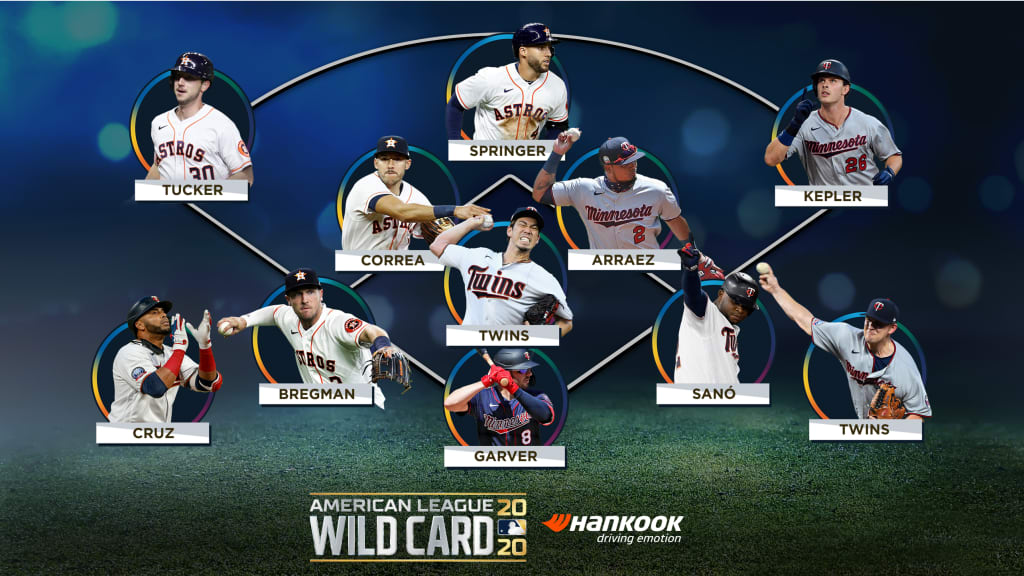
The Twins and Astros enter their 2020 Wild Card Series in pretty different situations. The Twins won their second straight American League Central title, racking up 36 wins, tied for second-most in the AL behind the Rays (40). They’ve now had a .600 or better winning percentage in back-to-back seasons for the second time in franchise history.
On the other hand, the Astros finished the season below .500 at 29-31, a year removed from a seven-game World Series loss to the Nationals. After three straight division titles and two World Series appearances, including a 2017 win, the tide turned for the Astros in '20. Once the titans of the AL, Houston is now in the postseason as a second-place team in the new format.
The Twins are in a position to be a perennial postseason pick for the next few years, while the Astros face numerous offseason questions. But in a three-game series, anything could happen.
Here’s a position-by-position breakdown of this exciting matchup in the AL Wild Card Series, with Game 1 today in Minnesota:
Catcher
Neither team has had particularly notable performances at the position this year, with the Twins tied for 13th and Astros ranking 16th in WAR from catchers per FanGraphs. Martín Maldonado was injured in the Astros’ loss on Friday, though manager Dusty Baker said on Sunday the team expects him to be fine.
Mitch Garver has struggled for the Twins and has been prone to more strikeouts, but his hard-hit rate was actually higher than last year, so that Bomba Squad power may still be there. And rookie Ryan Jeffers was a worthy fill-in and has impressed. He hit .273 on the year and was 75th-percentile in framing.
Advantage: Twins
First base
Yuli Gurriel slugged a career-high .541 last season, but he followed that up with just a .384 slugging percentage this season. He did have two outs above average, tied for third-most among first basemen, but that’s not enough to give him an edge -- not when the Twins’ primary first baseman is none other than Miguel Sanó. Sanó only hit .204, and even his .478 slugging percentage seems below what we’ve come to expect from him, but there’s no question he crushed the ball. He was 100th-percentile in average exit velocity and 98th-percentile in hard-hit rate. He hit three 440-foot homers, and six of his home runs had at least 110 mph exit velocity. He was above-average defensively in his first year primarily playing first, too, with one OAA.
Advantage: Twins
Second base
There’s no other way to put it: José Altuve had a down year. His batting average, on-base percentage and slugging percentage were all career-lows. He’s a career .290 hitter in the playoffs in an even 50 games played, so anything can happen, but his preceding regular seasons in each other year were all a lot better.
On the other hand, Luis Arraez didn’t play as many games as Altuve, missing time with a left knee injury, but when he did play, he hit. Arraez hit .321 in 121 plate appearances. And as usual, he made a ton of contact, with an 89.9% contact rate, well above the Major League average. That prowess could be especially helpful in the playoffs, where every pitch and each swing takes on even more importance.
Advantage: Twins
Shortstop
Jorge Polanco had a breakout season in 2019, which led to his initial '20 projections from The Shredder having him as the sport’s eighth-best shortstop ahead of Carlos Correa. After hitting .295 in ‘19 with a .485 slugging percentage, Polanco finished '20 at .258 and .354, respectively. Polanco adeptly avoided strikeouts yet again, with a career-best 14.9% strikeout rate and a low whiff rate, too.
Correa’s average and slugging percentage were quite close to Polanco’s, at .264 and .383, but Correa separates himself on the field defensively. He was above-average at shortstop, with two OAA, and had the third-best average arm-strength on max-effort throws among infielders, at 87.2 mph.
Advantage: Astros
Third base
This is a close one, as both teams have a well-established, productive third baseman with a good defensive reputation, too. Josh Donaldson played in just 28 games in his first season in Minnesota due to injuries, and left his most recent game on Friday with a right calf cramp. Marwin Gonzalez played most frequently in Donaldon’s regular-season absences, hitting .211 and slugging .320.
Alex Bregman also missed time due to injury, with right hamstring discomfort, but he has played consistently since returning on Sept. 8. His offensive numbers were down compared to his 2019 second-place MVP campaign, but he still had a below-average strikeout and whiff rate, plus two OAA. If Donaldson is fully healthy, this would be a bit closer, but as it stands now, the advantage goes to the Astros.
Slight advantage: Astros
Left field
Eddie Rosario had a good season, with a 110 wRC+, where 100 is league average, and a 14.5% strikeout rate. But Astros left fielder Kyle Tucker had one of the more underrated seasons in 2020, with a 125 wRC+ and .512 slugging percentage. He hit the ball hard, with 83rd-percentile average exit velocity and an 80th-percentile hard-hit rate. He also got it done in the outfield, with three OAA, third-most among left fielders.
Advantage: Astros
Center field
Both of these teams have outstanding center fielders. Head to either George Springer’s or Byron Buxton’s Statcast pages, and you’ll see a ton of red -- meaning they’re both "great" in a number of categories. Buxton, who also left the game injured on Friday but is expected to be ready for the postseason, had a career-best wRC+ this season, along with 99th-percentile sprint speed and three OAA.
But Springer, who is a free agent after the season, had the second-best wRC+ of his career at 143, as well as a career-low strikeout rate. He hit the ball nearly as hard as he did last year, and had an expected batting average of .307 and expected slugging percentage of .600, both of which are based on quality of contact, plus strikeouts. Buxton has the edge with speed and defense, but Springer’s offense, and still above-average defense and speed, give him the overall advantage here.
Very slight advantage: Astros
Right field
Josh Reddick was worth negative WAR this season for the first time in his career, as his strikeout rate went up from 12.0% last year to 19.4% this year and his batting average dropped from .275 to .245. Twins right fielder Max Kepler also saw his performance dip from a year ago -- but his 2019 ended up netting him down-ballot MVP consideration. After slugging .519 last year, he had a .439 mark in 2020, but he was still above-average in wRC+. Neither outfielder was outstanding in right field, but Kepler was above average at one OAA, while only one right fielder had fewer OAA than Reddick’s -4.
Advantage: Twins
Designated hitter
Michael Brantley had another reliable season, hitting .300 and slugging .476. Like usual, his strikeout rate and whiff rate were both well below league average. But the Twins’ designated hitter is Nelson Cruz -- the ageless wonder, who at 40 years old had yet another high-powered slugging season. He did deal with knee soreness toward the end of the season, but played in the Twins' final three games of the year. Cruz crushed the ball, with 88th-percentile exit velocity, knocking 16 home runs in 214 plate appearances. Not to mention, he led the Majors in naps and used his Donaldson-gifted bathrobe as a fashionable home run celebration.
Advantage: Twins
Rotation
The Astros’ rotation was dealt a blow when Justin Verlander’s Tommy John surgery was announced, ending chances of a late-season Verlander return. Framber Valdez’s continued emergence was a boon to the club, and a fully healthy Lance McCullers Jr. has been good, especially lately. Veteran Zack Greinke struggled in his first start last postseason and never fully righted the ship in October. Overall in 2020, the team had a 4.14 starters ERA, 11th in the Majors.
The Twins, meanwhile, ranked fifth in the Majors and second in the AL in rotation ERA at 3.58. Free-agent signing Kenta Maeda had a year that would’ve merited serious Cy Young conversation in a non-Shane Bieber season, with a 2.70 ERA and more than 10 strikeouts per nine innings, plus a deep no-hit bid. Along with Opening Day starter Jose Berrios and Michael Pineda who returned later in the year, Minnesota’s rotation seems ready.
Advantage: Twins
Bullpen
The Astros’ bullpen had a 4.39 ERA, 16th in the Majors this year. Closer Ryan Pressly’s ERA went up by more than a run, and the bullpen included a number of rookies throughout the year, so it’s hard to know what to project from them in the postseason. The team had 13 blown saves, second-most in the Majors behind the Angels (14). The Twins’ bullpen was sixth in the Majors in ERA at 3.62. Closer Taylor Rogers did not reprise his 2019 success, but Tyler Clippard and Tyler Duffey both had ERAs below 2.80 in more than 20 appearances each, along with other strong contributors.
Advantage: Twins
